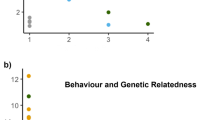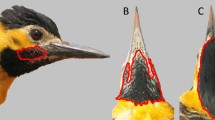Summary
Variance in male reproductive success in single and multi-male red howler (Alouatta seniculus) troops was examined through paternity exclusion using genetic markers. Coalitions of relatives were compared to coalitions of non-relatives with regard to duration, stability, and number of offspring expected for each participant based on paternity exclusion results. No evidence of paternity by males living outside of the troop was found. In multi-male troops, only the dominant male was found to father offspring conceived during his tenure. This was the only male observed to mount females. In both troops examined genetically wherein a status change had occurred, paternity changed with status. Coalitions of relatives and potential relatives lasted significantly longer than coalitions of non-relatives, and experienced fewer status changes between males. A direct advantage of forming a coalition for both dominant and subordinate red howler males resulted from the superior competitive ability of coalitions over single males in establishing and maintaining tenure in the limited number of female troops in the population. Although the mating success of a subordinate male in a coalition appears to be extremely low, his chances of achieving membership in a bisexual troop as a single male may be even lower. Since the majority of troops in the population during any given year were multi-male or age-graded male (85%–96%), the number of troops that a single male would be able to invade unaided was very small. A subordinate male may be able to assume dominance, particularly if he is a subadult. In coalitions in which males are related, the subordinate male will further benefit from inclusive fitness. A dominant male that forms a coalition with a relative can expect to have longer reproductive tenure than in a troop with a non-relative, thereby producing more offspring and directly enhancing his fitness. Anecdotal evidence suggests that males choose relatives over non-relatives as coalition partners when possible.
Similar content being viewed by others
References
Altland K, Hackler R, Knoche W (1980) Double one-dimensional electrophoresis of human serum transferrin: a new high resolution screening method for genetically determined variation. Hum Genet 54:221–231
Altmann SA (1962) A field study of the sociobiology of rhesus monkeys, Macaca mulatta. Ann NY Acad Sci USA 102:338–435
Brown JL (1987) Helping and communal breeding in birds: ecology and evolution. Princeton University Press, Princeton, NJ
Bygott JD, Bertram CR, Hanby JP (1979) Male lions in large coalitions gain reproductive advantages. Nature 282:839–841
Crockett CM (1984) Emigration by female red howler monkeys and the case for female competition. In: Small MF (ed) Female primates: studies by women primatologists. Alan R Liss, New York, pp 159–173
Crockett CM (1985) Population studies of red howler monkeys (Alouatta seniculus). Nat Geogr Res 1:264–273
Crockett CM, Eisenberg JF (1987) Howlers: variations in group size and demography. In: B Smuts, D Cheney, R Seyfarth R Wrangham, T Struhsaker (eds) Primate societies. University of Chicago Press, Chicago, pp 54–68
Crockett CM, Pope TR (1988) Inferring patterns of aggression from red howler monkey injuries. Am J Primatol 14:1–21
Crockett CM, Rudran R (1987) Red howler monkey birth data 1: seasonal variation. Am J Primatol 13:347–368
Crockett CM, Sekulic R (1984) Infanticide in red howler monkeys (Alouatta seniculus). In: Hausfater G, Hrdy SB (eds) Infanticide: comparative and evolutionary perspectives. Aldine, New York, pp 173–191
Duvall SW, Bernstein IS, Gordon TP (1976) Paternity and status in a rhesus monkey group. J Reprod Fertil 47:25–31
Harris H, Hopkinson DA (1977) Handbook of enzyme electrophoresis in human genetics. North-Holland, Amsterdam
Hausfater G (1975) Dominance and reproduction in baboons. In: Kuhn H, Luckett WP, Novack CR, Schultz HA, Starck D, Szalay FS (eds) Contributions to primatology, vol 7. S Karger, Basel, pp 1–150
Loy JD (1971) Estrous behavior of free-ranging rhesus monkeys (Macaca mulatta). Primates 12:1–31
McClellan T (1982) Electrophoresis buffers for polyacrylamide gels at various pH. Anal Biochem 126:94–99
Neville MK (1972) The population structure of red howler monkeys (Alouatta seniculus) in Trinidad and Venezuela. Folia Primatol 17:56–86
Packer C, Pusey AE (1982) Cooperation and competition in coalitions of male lions: kin-selection or game theory? Nature 296:740–742
Packer C, Pusey AE (1983) Male takeovers and female reproductive parameters: a simulation of estrous synchrony in lions (Panthera leo). Anim Behav 31:334–340
Peto R, Pike MC, Armitage P, Breslow NE, Cox DR, Howard SV, Mantel N, McPhearson K, Peto J, Smith PG (1976) Design and analysis of randomized clinical trials requiring prolonged observation of each patient. I. Introduction and design. Br J Cancer 34:585–612
Peto R, Pike MC, Armitage P, Breslow NE, Cox DR, Howard SV, Mantel N, McPhearson K, Peto J, Smith PG (1977) Design and analysis of randomized clinical trials requiring prolonged observation of each patient. Br J Cancer 35:1–30
Pope TR (1989) The influence of mating system and dispersal patterns on the genetic structure of red howler monkey populations. Ph.D. dissertation. University of Florida, Gainesville
Reisner AH, Nemes P, Bucholtz C (1975) The use of Coomassie brilliant blue G250 perchloric acid solution for staining in electrophoresis and isoelectric focusing on polyacrylamide gels. Anal Biochem 64:509–516
Ridpath MG (1972) The Tasmanian native hen, Tribonyx mortierd. I–III. CSIRO Wildl Res 17:1–118
Rudran R (1979) The demography and social mobility of a red howler (Alouatta seniculus) population in Venezuela. In: Eisenberg JF (ed) Vertebrate ecology in the northern neotropics. Smithsonian Institution Press, Washington, DC, pp 107–126
Saavedra CJ (1984) Spatial and social relationships of males in two groups of red howler monkeys (Alouatta seniculus). Masters thesis. University of Florida, Gainesville
Scott NJ, Scott AF, Malgrem LA (1976) Capturing and marking howler monkeys for field behavioral studies. Primates 17:527–533
Sekulic R (1981) The significance of howling in the red howler monkey (Alouatta seniculus). Ph.D. dissertation. University of Maryland, College Park
Sekulic R (1982) Behavior and ranging patterns of a solitary female red howler (Alouatta seniculus). Folia Primatol 38:217–232
Sekulic R (1983) Male relationships and infant deaths in red howler monkeys (Alouatta seniculus). Z Tierpsychol 61:185–202
Selander RK, Smith MH, Yang SY, Johnson WE, Gentry JB (1971) Biochemical polymorphism and systematics in the genus Peromyscus. I. Variation in the old-field mouse (Peromyscus polionotus). Univ Texas Publ 7103:49–90
Smith DG (1981) The association between rank and reproductive success in male rhesus monkeys. Am J Primatol 1:83–90
Smuts BB (1985) Sex and friendship in baboons. Aldine, Hawthorne, NY
Smuts BB (1987) Sexual competition and mate choice. In: Smuts B, Cheney D, Seyfarth R, Wrangham R, Struhsaker T (eds) Primate societies. University of Chicago Press, Chicago, pp 385–400
Sokal RR, Rohlf IL (1969) Biometry. W.H. Freeman, San Francisco
Struhsaker TT (1967) Behavior of vervet monkeys (Cercopithecus aethiops). Univ Calif Publ Zool 82:1–64
Thorington RW, Rudran R, Mack D (1979) Sexual dimorphism of Alouatta seniculus and observations on capture techniques. In: JF Eisenberg (ed) Vertebrate ecology in the northern neotropics. Smithsonian Institution Press, Washington, DC, pp 97–106
Troth RG (1979) Vegetational types on a ranch in the central Ilanos of Venezuela. In: Eisenberg JF (ed) Vertebrate ecology in the northern neotropics. Smithsonian Institution Press, Washington, DC, pp 107–126
Author information
Authors and Affiliations
Rights and permissions
About this article
Cite this article
Pope, T.R. The reproductive consequences of male cooperation in the red howler monkey: paternity exclusion in multi-male and single-male troops using genetic markers. Behav Ecol Sociobiol 27, 439–446 (1990). https://doi.org/10.1007/BF00164071
Received:
Accepted:
Issue Date:
DOI: https://doi.org/10.1007/BF00164071




